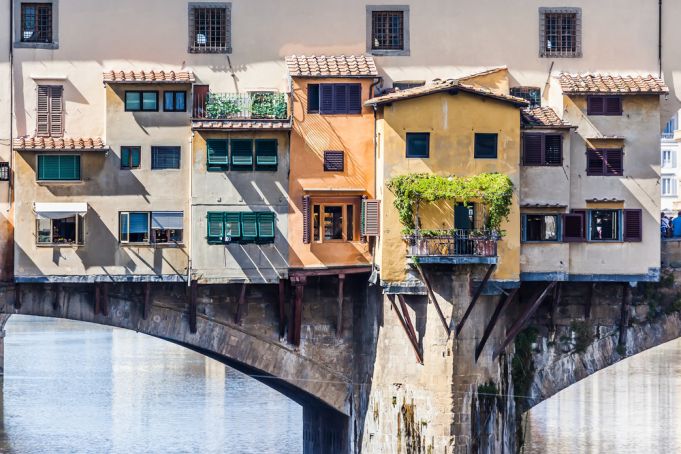A brief history of Ponte Vecchio, the Old Bridge in Florence
Ponte Vecchio is the most famous bridge in Florence.
It earned its name, "Old Bridge," by surviving a long and exciting history. It's possible that the bridge existed in some form during the Roman Empire, but it was first recorded as being a defensive structure in Medieval Italy.
The bridge, built of stone and wood, crosses the most narrow point of the Arno River and connects the City Center to the district of Oltrarno. The structure is such an anomaly because it doubles as a marketplace for gold goods and fine jewelry. There are five important years that contribute to Ponte Vecchio's longevity and beauty:
1345 - Surviving the floods
The floods of the Arno River often got the better of Ponte Vecchio before 1345. It fell for the last time in 1333 due to its unsupportive construction. In 1345, the Florentines rebuilt it with three segmental arches for extra insurance. This is the bridge that survived a flood in 1966 and remains standing today. The reconstruction is credited to either Taddeo Gaddi or Neri di Fioravante. At the same time, 43-46 shops became part of the structure. Since the laws at the time enforced that the shops not be built on the pavement, they hung over the river, supported by wooden stakes.
1442 - The Shops on the Bridge
Before 1422, the shops were available for rent to shopkeepers of any discipline. In 1442, the ownership of the marketplace became monopolized by grocers, butchers, and fishmongers as the government tried to control the cleanliness of the city. This way, the government could easily control the spread of the mess and smell that came with the business of food sales, and the tradesmen could throw their waste directly into the river. In 1495, though, after the grocers bought ownership of all the shops, the government lost control of the marketplace's cleanliness and the odor eventually became undeniable. This was to be remedied over a century later.

1565 - The Vasari Corridor
In 1565, Cosimo I de'Medici commissioned architect Giorgio Vasari to construct the Vasari Corridor, which still stands atop the Ponte Vecchio marketplace. The one-kilometer-long bridge took only five months to make as the Medici family ordered a speedy construction to be ready in time for the marriage of Francesco Medici and Joanna of Austria.
The corridor made it safer for the Medici family to cross the river since it connected their Pitti Palace to the Palazzo Vecchio. The quick construction also explains its odd shape, as it still winds around the Mannelli tower. The Mannelli family refused demolition to make way for the corridor and Medici conceded. Today, the corridor is part of a museum and a house to paintings.
1593 - The Marketplace
This was the moment when Ponte Vecchio finally transformed into the marketplace that we know today. The collection of butchers and fishmongers under the Vasari Corridor disrupted the noble life of the royal family of Tuscany. It's said that when Ferdinando I, Grand Duke could no longer take the smell, he outlawed the trade of raw goods there and promoted more noble business: jewel and art salesmen. As Florence was becoming a center for Renaissance art, the Duke hoped this change might entertain the new elite visitors.
1944 - World War II
During WWII, German troops targeted the bridges along the Arno river for control of the city and its mobility. They destroyed all of the crossings except for Ponte Vecchio in 1944. The pavement walkway was made inaccessible by demolition of its access points, but the floating market itself was left untouched. The only way to cross the Arno River during this time was through the Vasari Corridor. The preservation may be due to Hitler's favorable comments concerning the view of the river from this particular bridge. But, it is credited to Gerhard Wolf, who was the German consul of Florence at the time. In 1955, he became an honorary citizen of Florence, and in 2007 Florence erected a marble plaque on the bridge in his honor.
Ponte Vecchio might be only a typical Italian commercial center if it wasn't for its surprising history and impressive construction. Instead, it's an international tourist destination and a place of business for some of the finest artisans in Italy and the recognizable Rolex. The best view of the bridge and its multi-colored buildings is from a boat trip along the Arno River.

















